The Samsung Galaxy S6 and S6 edge Review
by Joshua Ho on April 17, 2015 9:00 AM EST- Posted in
- Smartphones
- Samsung
- Mobile
- Galaxy S6
- Galaxy S6 Edge
System Performance
In order to test the Exynos 7420 and the phone in general, we turn to our suite of benchmarks which are able to show how the device performs in common general computing workloads. Something as simple as web browsing is still surprisingly intensive on mobile phones, and in general Android can often be quite stressful to run in the constraints of a ~3W total TDP especially on any phone still running Dalvik due to its strong reliance on bytecode and a virtual machine that translates bytecode to machine code just before and during application runtime. ART improves this significantly, but is limited in the nature of optimization as AOT compilation optimizations are limited by the CPU power of the SoC and the need to compile the application in a reasonable amount of time.
As always, we'll start things off with our browser benchmarks. After getting to use the phone, it became clear to me that Chrome is poorly optimized against the Galaxy S6 as Samsung’s browser is clearly superior in performance. For that reason I've gone ahead and run our benchmarks on both Chrome and on the stock browser, as seen below.

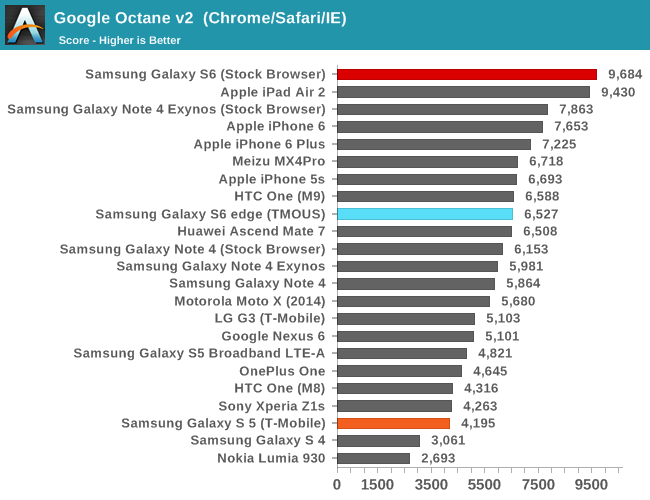

Needless to say, in order to see the full potential of the Exynos 7420 and its cluster of A57s, it’s necessary to use Samsung’s stock browser. This performance is really quite amazing when compared to Apple’s A8X, which has basically been the gold standard for performance in the mobile space in the context of ARM SoCs.
Moving on, as a part of our updates to the benchmark suite for 2015, we'll take a look at Basemark OS II 2.0, which should give a better picture of CPU performance in addition to overall device performance.
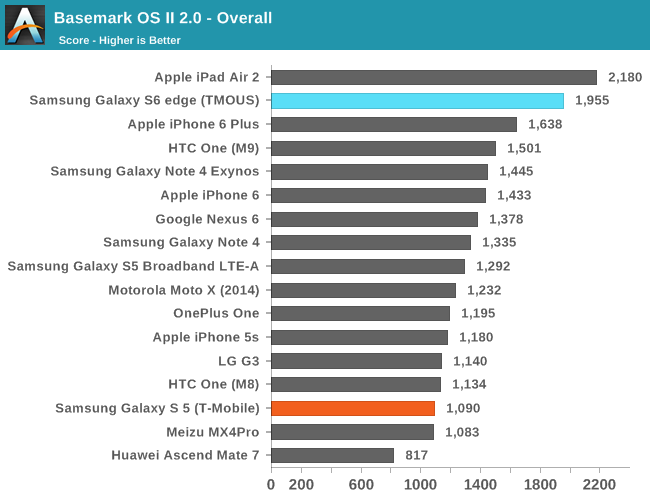
The browser benchmarks seem to hide some pretty enormous variability as the Galaxy S 6 edge (which is comparable to the Galaxy S 6) sets a new record among Android devices. The only challenger is the iPad Air 2, which uses the A8X SoC with three Enhanced Cyclone cores and the semi-custom GXA6850 GPU.
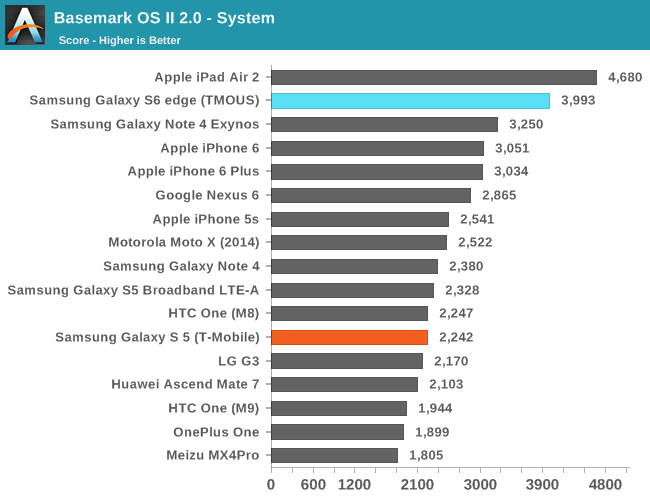
This system test contains a floating point and integer test, in addition XML parsing, which means that this test mostly stresses CPU and RAM. Interestingly enough, the Exynos 7420 pulls far ahead of both the Exynos 5433 and Snapdragon 810 in this test, and approaches the A8X. The difference between the 5433 and 7420 is likely a combination of the higher clocks on both the A57 and A53 clusters for the 7420 (1.9/1.3 on the 5433, 2.1/1.5 on the 7420), in addition to the ability to stay at a high 'overdrive' clock due to reduced leakage from the 14LPE process. The One M9 likely falls a bit short here due to HTC's governor settings restricting the use of all 8 cores simultaneously.

While one might guess that the memory test of 'Basemark OS II 2.0 - Memory' is of RAM, this is actually a test of the internal storage. Once again we see the S6 edge come close to leading the pack due to the use of the new UFS (Universal Flash Storage) standard. Casual examination reveals that the S6 edge has a queue depth of 16, and that it identifies itself with the rather cryptic model name of KLUBG4G1BD-E0B1.
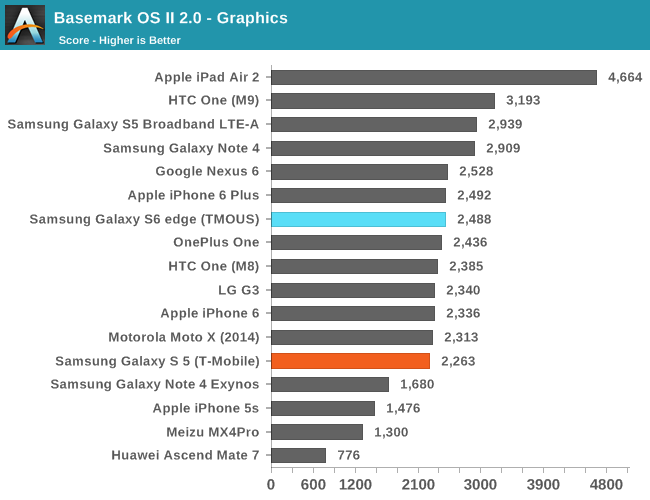
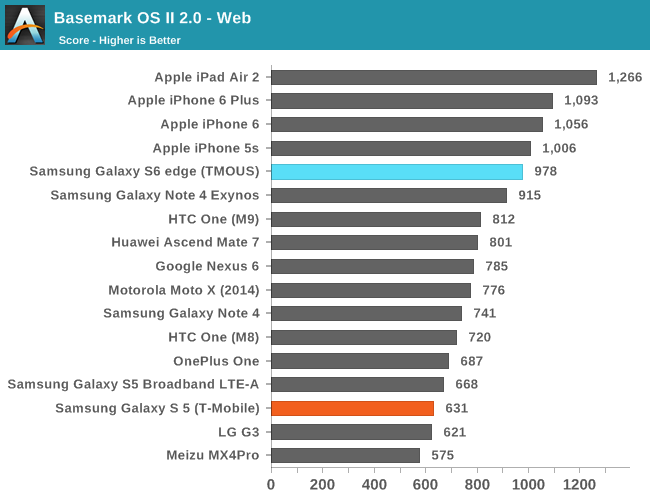
For the web test, it uses the built-in WebView rendering engine rather than Chrome and paints a distinctly different picture, especially because these tests are focused on HTML5 and CSS rather than JavaScript. Here we can see that the iPhone 6 and iPad Air 2 continue to hold their lead, but the Galaxy S6 is pretty much the king of the hill when it comes to Android devices.
Our next system benchmark is PCMark, which does a number of basic benchmarks designed to stress various aspects of the device in everyday workloads like video playback, web browsing, text editing, and photo editing. This tends to test every aspect of a mobile device, unlike microbenchmarks that can often miss aspects of the system that can affect performance.
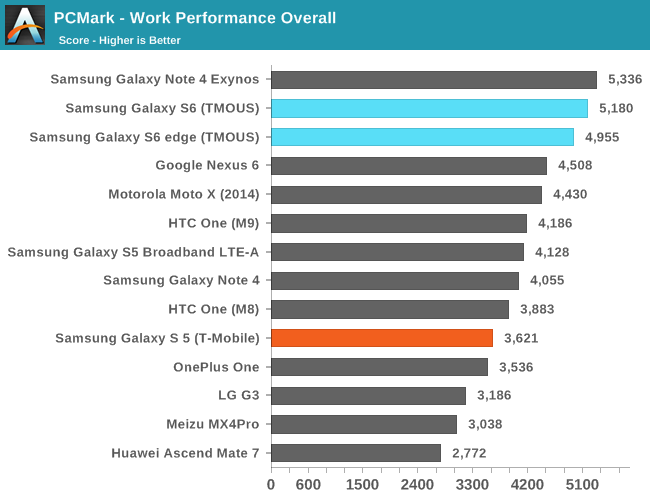
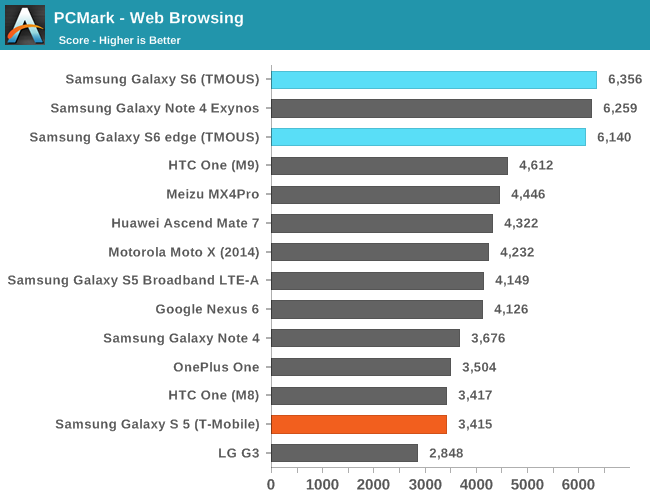
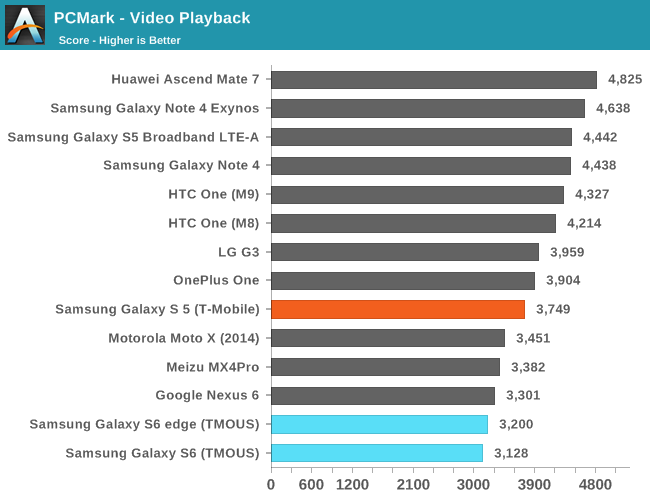
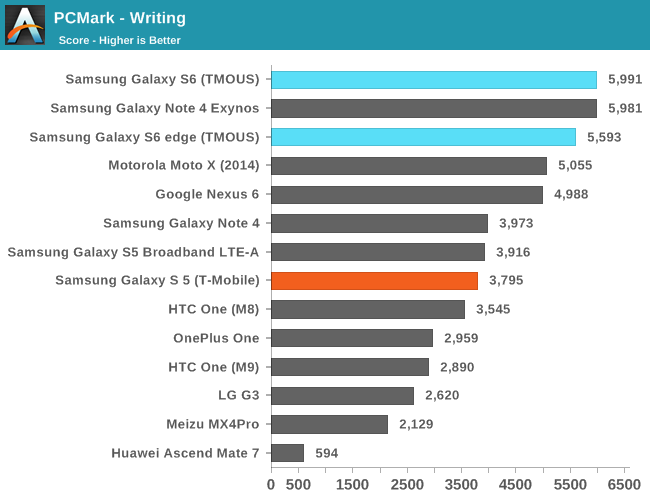

In these tests, the Galaxy S6 continues to perform strongly here due to the fast NAND storage solution and the Exynos 7420 SoC. As we have already covered the Basemark OS II 2.0 results in previous articles, I would refer back to it as those scores are final and have already been contextualized.
Overall, in these general purpose computing tasks that stress CPU, memory, and NAND performance we can see that the Exynos 7420 is off to a flying start. Samsung Mobile should focus more strongly on optimizing the software stack against Chrome as mobile Chrome has around twice the user share of stock Android browsers. I often say that the SoC is the foundation to a good smartphone, and in the case of the Galaxy S6 it feels like this is especially true.










306 Comments
View All Comments
nerd1 - Friday, April 17, 2015 - link
Glad that anandtech FINALLY included the browser benchmarks using sammy's stock browser.lilmoe - Friday, April 17, 2015 - link
It's an improvement. But still, "browser benchmarks" are just that; a benchmark to software side of the browser engine. It's only good for testing CPU performance when we're ONLY looking at generation improvements of the *same* platform/browser/OS.I wish we had a more "open"/transparent cross platform benchmarking suite... Anyway, it looks Exynos is truly back as a market leader, as in being a generation above everything else. I'd expect it to stay in lead well till the Note 5 is here.
nerd1 - Friday, April 17, 2015 - link
"Although the dynamic range of the Galaxy S6’s IMX240 sensor is inherently lower than an equivalent 1.5 micron pixel-size sensor due to the nature of CMOS image sensors"This is not true. Pixel size rarely affects daylight dynamic range of the sensor. D800 series (36MP FF sensor) has actually tiny bit wider dynamic range than 12MP FF sensor of A7s.
Alien959 - Friday, April 17, 2015 - link
Yes, that's true for dslr's because they still have large enough pixel size so dynamic range isn't affected. Even d800 have many times larger pixel photo sensor than 1.5 micron used in SG6. For bigger densities in smaller sensors dynamic range is lower compare some high end compact like panasonic LX7 and cheap point and shoot.nerd1 - Friday, April 17, 2015 - link
Various review sites direct comparison between phone cameras and Note 4/GS6 actually had LESS highlight clipping than iPhone 6.Alien959 - Friday, April 17, 2015 - link
Yes, I have read some of the so maybe sony definitely improved the sensor so samsung is using that versus their own. Different generation sensor and processing also affect the final image.Hairs_ - Friday, April 17, 2015 - link
It's a very hindsight-heavy negative view of the s5 in this review. I'm surprised sales weren't great for it as it fixed most of the issues with the s4's performance and camera.Losing waterproofing, removable battery and SD card are killers for me but apart from that I don't see what makes the s6 a brilliant. The improved software performance will hopefully be brought down to older devices, the improvements in SOC design and battery efficiency are offset by the pointless resolution increase, and the mantra "must follow apple's cue to be considered premium" isn't convincing.
Switching to white backgrounds for apps wastes the advantage of AMOLED as well.
Still, it's selling well so I doubt Samsung care.
lilmoe - Friday, April 17, 2015 - link
The GS5 didn't sell well because of "perception", not merit. It was a HUGE upgrade over the GS4 in almost every aspect IMHO. I'm one of those who actually liked the "band-aid" plastic back. I would have preferred if Samsung made the GS6 closer to the Alpha's design; metal frame with plastic back, but less squarish (IE: the same exact shape/corners of the GS6 but with the same plastic back as the Alpha).I believe that Samsung nailed the design with the Alpha and Note 4, but it seems that reviewers and consumers didn't agree. That stupid twisting of the back cover by reviewers to prove that it was "flimsy" only proved that they were completely ignorant of the quality of materials and the functionality/practicality it entails.
Ammaross - Friday, April 17, 2015 - link
Yep. It's the reviewers that forced Samsung's hand into copying the metal+glass design that the iPhone has. Personally, I think it's horrible as the S6's glass back makes it far too slippery in-hand. I'm definitely putting a bumper on it just so I can hold on to it (which of course entirely defeats the metal+glass design anyway!). Plastic does not mean "cheap," merely flexible (in application/texture, not just robustness).FlushedBubblyJock - Friday, April 17, 2015 - link
Well, yes, I agree, the reviewers had nothing but disdain if it wasn't "the solid and simple apple industrial design that feels expensive in my hand" but add in the drooling sheep and parrots in their responses, they certainly totally contributed as well.Since these people function on mindless perception, not facts, we have the cloned result.